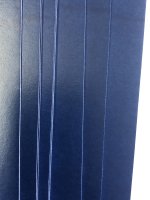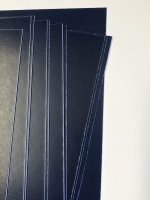sidneykidney
Well-known member
Hi all you experts out there.
I've printed a menu on my Xerox Versant 80 toner based digital press which is 2 sheets of 350gsm Silk.
Both sheets have a solid blue background and they are then duplex glued back to back and after 24 hours I guillotine to A5.
Front side looks excellent with nice clean edges but the reverse side is rough with flaking edges because I'm cutting against the toner.
I understand that laminating would cure the problem but does anyone have any solutions without laminating.
I've tried the following but still to luck:
1 - Printing on Silk, Gloss & Uncoated
2 - New blade on the guillotine
3 - Guillotine with the good edge facing outside of the blade instead of inside.
4 - Lots of waste card above and below the print job when cutting on the guillotine.
See attached pics of the front and back
I've printed a menu on my Xerox Versant 80 toner based digital press which is 2 sheets of 350gsm Silk.
Both sheets have a solid blue background and they are then duplex glued back to back and after 24 hours I guillotine to A5.
Front side looks excellent with nice clean edges but the reverse side is rough with flaking edges because I'm cutting against the toner.
I understand that laminating would cure the problem but does anyone have any solutions without laminating.
I've tried the following but still to luck:
1 - Printing on Silk, Gloss & Uncoated
2 - New blade on the guillotine
3 - Guillotine with the good edge facing outside of the blade instead of inside.
4 - Lots of waste card above and below the print job when cutting on the guillotine.
See attached pics of the front and back













